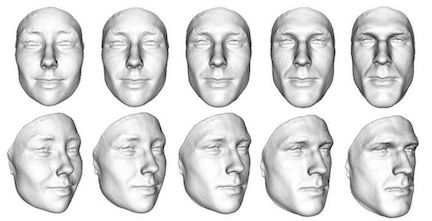Researchers Examine Gender Differences in Facial Size and Shape to Aid Those Seeking Gender-Affirming Facial Surgery
Posted on Apr 13, 2022 | Comments 0
 Researchers from the University of California, San Francisco and the University of Calgary set out to quantify the effect of sex on adult facial size and shape through an analysis of three-dimensional facial surface images. Their work aimed to help transgender individuals who desire facial features that better reflect their gender identity. Until now, there have been few objective guidelines to justify and facilitate effective surgical decision-making for gender-affirming facial surgery.
Researchers from the University of California, San Francisco and the University of Calgary set out to quantify the effect of sex on adult facial size and shape through an analysis of three-dimensional facial surface images. Their work aimed to help transgender individuals who desire facial features that better reflect their gender identity. Until now, there have been few objective guidelines to justify and facilitate effective surgical decision-making for gender-affirming facial surgery.
In a study published on the website of the journal Facial Plastic Surgery & Aesthetic Medicine, the investigators undertook a surgically oriented analysis of 3D facial size and shape to quantify and visualize facial sex differences. Their findings reveal significant differences in both shape and size of male and female craniofacial features and provide data-driven anatomic guidance and justification for gender-affirming facial surgery, particularly for forehead contouring cranioplasty, mandible and chin alterations, rhinoplasty, and cheek modifications.
The researchers were able to determine that, on average, male faces are 7.3 percent larger than female faces. Sex was associated with significant facial shape differences in the entire face as well as in each sub-region considered in the study. The facial regions in which sex has the largest effect on shape are the brow, jaw, nose, and cheek. The authors, therefore, provide supportive evidence and guidelines for the appropriate alterations of these facial areas for GFS, although each individual patient’s goals and face is unique.

An example subject (center column) that has been transformed to have a more masculine (right) and more feminine (left) shape, leaving overall size unchanged.
“Our purpose was to establish an important, definitive, and biologically-based relationship of facial features to sex. This empowers the patient to navigate towards a facial appearance that matches with their gender identity, and thereby reduces mis-gendering and gender dysphoria while improving self-perception,” said senior author Rahul Seth, an associate professor of facial, plastic, and aesthetic surgery in the department of otolaryngology-head and neck surgery at the University of California, San Francisco. “We feel that this data provides surgeons, patients, and insurance payors with a life-like and surgically- oriented analysis of 3D facial size and shape to guide patients and surgeons in performing these complex and life-altering surgeries.”
Filed Under: Research/Study








